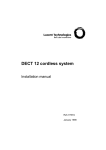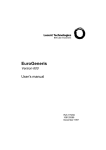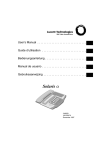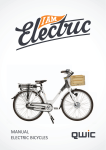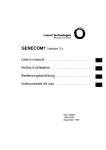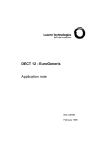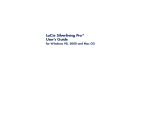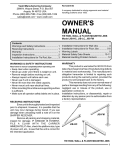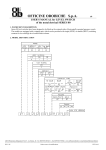Download User manual - Hjelpemiddeldatabasen
Transcript
Spare parts User manual 1 Release knob V29A-1025 2 Handle V31-610 3 Lock U1-026 4 Clip T518001 5 Pin V56-1234 6 Guide U1-024 7 Spring pushbutton NU_ANG_Hippolib_02-2014_Photos non contractual_Printed on FSC certified paper. 8 Knurled knob Hippo V57A-1228 V30FOP-647 Made in France Restrictions of use / Precautions for use Definition Some parts swivel and may cause pinching. Check the condition of the module fastening strap very frequently. In the event of wear, replace it before subsequent use. The task of fitting the device on the saddle must be carried out by professional riding personnel. The presence of accompanying persons is necessary to enable disabled people to go riding. Use of a suitable transfer method (mounting block or rider lifter) is strongly recommended to enable these people to mount. Never modify any elements of the module structure. For use on a pony saddle, put the girth through the slot. Saddle module for use as a horse riding aid. Description The module is made up of two main elements, the front part (abdominal support and handle) and a rear part (backrest). The unit is held in place by a fastening system that goes under the saddle to hold the two parts in place. Girth slot Rear part Cleaning / Storage Store the product in a dry place Do not soak it Use a damp cloth to clean the leather and metal parts The covers can be removed and washed at 30 °C Front part Do not : 30 Dry clean Iron Use chlorinated products Machine dry Guarantee Group The guarantee covers a one-year period provided that the module is used in compliance with the manufacturer’s instructions as from the date of purchase of the product. Visit our website : www.groupe-g2m.com Mouvly - Groupe G2M 168 ZA des Aubrières - 49412 SAUMUR Cedex www.mouvly.com - 02 41 50 50 91 - [email protected] 1 12 Releasing device Purpose If the rider loses his or her balance, putting too much stress on the abdominal support, a device is fitted to pivot automatically and release bar No. 2, thus freeing the rider. Device designed to make it easier for people to learn to ride a horse. Its design also makes it suitable for the disabled. The sensitivity of the device can be adjusted to suit the rider’s weight. Compatibility This device is compatible with most standard saddles used in riding stables and pony clubs. However, it is not suitable for certain models, such as pommel saddles. In case of doubt, contact our customer service client to check for compatibility. Patent A patent application has been made to the INPI concerning this equipment, under the No. 12/01875. Check the contents of the bag The mechanism can be adjusted to obtain a suitable level of resistance to : Remove the protective cloth cover clipped onto the casing. Use a ring spanner to loosen the locknut, and then use an Allen key to adjust the locking finger (tighten to increase the releasing force, or loosen to reduce the releasing force). Then re-tighten the locknut to keep the setting. Carry out the same operation on both mechanisms. Test the sensitivity by pressing bar No. 2. Casing It is advisable to check the setting from time to time. Check the setting systematically if the mechanism trips during use. It must contain : A front part with a handle A rear part with a high back and a shell type back Locknut Front part Rear part Locking finger Figure 1 - Part index 2 12 11 12 The module is now operational and correctly adjusted. Stages for fitting and adjusting the module on the saddle Start by adjusting the rear part to suit the shape of your saddle. The inner part of the saddle should have a central groove between the two pads. Stage 8 : Dismounting Before the rider dismounts, repeat the procedure in stage 3, operation 3.1 removal of the "abdominal support" from the front part, and then operation 3.2 removal of the backrest from the rear part. If the rider is disabled, we recommend using a mounting block or a "rider lifter" with the help of other persons. Stage 9: Removing the module from the saddle Unsaddle the horse, turn it over and press the locking lever on strap buckle No. 22. Strap No. 21 slips off pulleys No. 9 – No. 10 and No. 11 and releases the two parts. Figure 2 Ancillary equipment Stage 1 : Adjusting the rear part to suit the shape of the saddle Handle Present the rear part, inserting rod No. 19 into the groove between the two pads under the saddle seat (see figure 2) until the hooks No. 14 and the support No. 13 reach their position at the back of the saddle. The grip handle No. 3 fitted on the front part is removable. It can be removed by pressing simultaneously on the two clips No. 8 located on the tubes of its lower part and pulling it forwards. The operation is easier if it is carried out while the front part is in place on its support No. 1 fixed to the saddle. To reinstall the handle on the front part, align and engage the two tubes in the guides, while holding down the two clips No. 8. Push handle No. 3 in until the two clips No. 8 lock into place in their housings No. 8a. Before use, check that the handle is securely locked in place by pulling it forward. The rear part is held firmly in place between rod No. 19 and the two sliding hooks No. 14. To change their position, pull on the adjusting knobs No. 15 and slide them along in their guides so that the hooks come into contact with the rear part of the saddle seat to obtain a suitable setting. When the hooks reach the desired position, release the knobs to lock them in the corresponding hole. Check that the knobs are fully inserted. The adjustment has now been made. Locking knob Sliding hooks Figure 3 - Details of the rear part Figure 10 10 12 3 12 Étape 2 : Montage du module sur la selle Stage 7 : Adjusting the abdominal support on the front part To watch a video showing how to fit the device on the saddle: http://www.youtube.com/watch?v=jErj3mM8Ok4 Once the front part has been fitted on its holder No. 1 and the rider is sitting against the backrest, loosen the upward and downward knurled knobs No. 6 and swivel the two elements holding supporting strip No. 2 to place the strip at the level of the rider’s pelvis. Retighten knurled knobs No. 6 after making the adjustment. Pull out the longitudinal adjusting knobs No. 5 and slide support strip No. 2 to bring it into contact with the rider’s pelvis (lower abdomen). To provide correct positioning and support, the surface of abdominal support No. 2 must come into contact at the level of the rider’s pelvis, but without pressing on it too hard. Leave a finger’s width between the strip and the rider’s lower abdomen. Release knobs No. 5 in the corresponding locking holes once the adjustment has been made. Fit the module before saddling the horse. Slide rod No. 4 on the front part along the groove between the two pads under the saddle seat (see figure 2) until hooks No. 7 come up against the front of the saddle. Upward and downward adjustments (knurled knobs No. 6) and front-rear adjustments (knobs No. 5) of strip No. 2 can be made asymmetrically on the right-hand and left-hand sides to provide optimum support. Front part Rear part Figure 4 Proceed in the same way for the rear part. Once the rear rod No. 19 has been fully inserted, the two sliding hooks No. 14 must be in contact with the rear part of the saddle seat. If this is not the case, it is necessary to adjust them to ensure optimum support (see stage 1). To fix the two parts (front and rear), place the saddle and module unit vertically, resting on the front part of the saddle, to be able to access the central groove between the two pads. Put the long part of strap No. 21 through the upper rear hook No. 11 and then the lower front hook No. 9. Slide the end of the long part of the strap into the jaws of buckle No. 22. Make sure the two parts (front and rear) are correctly aligned on the saddle and then pull progressively and vigorously on strap No. 21 (see figure 5). Front part Rear part Abdominal support strip Longitudinal adjustment knob Knurled upward/ downward adjustment knob Double reeving system to attach the saddle module Upper front pulley Upper rear pulley 11 10 Tightening force Figure 8 - Details of the front part Before use, check that the abdominal support strip is securely locked in place by pulling it gently upwards, and pushing it backwards and forwards Locking buckle 21 22 9 Lower rear pulley Long part of strap 4 12 Figure 5 9 12 Check before use that the module is securely fixed to the saddle. If not, pull the strap tighter and make sure that the setting of the sliding hooks No. 14 on the rear part provides a clearance-free grip on the rear part of the saddle. If not, readjust the setting of the sliding hooks No. 14 (stage No. 1) and retighten the strap. Stage 3 : Preparing the saddle to enable the rider to mount To make it easier for the rider to get astride the saddle when mounting, it is advisable to remove the "abdominal support" from the front part and the backrest from the rear part. Locking knob Sliding hooks To remove the «abdominal support» section from the front part, put your hand in handle No. 3 and press the release button No. 20 with your thumb. Pull the "abdominal support" section upwards while holding button No. 20 down until the section comes out of the front holder No. 1. Figure 8 - Details of the rear part The rider is now seated in the saddle and up against the backrest. Stage 6 : Reposition the "abdominal support" by putting your hand in handle No. 3 and pressing your thumb on the release knob No. 20 (same position as for removing it – operation 3.1 - figure 6 - page 5) so that it is correctly aligned with the guide tubes. The unit must slide easily into place. If you find that it catches, this is because the tubes are not correctly aligned with the rods. Push the assembly fully in onto support No. 1 and then release knob No. 20 to lock it in place. Before use, check that the system is securely locked in place by pulling it upwards hard. 8 12 Figure 6 - Details of the system used to remove the abdominal support 5 12 The different types of backrests 3.1 To remove the backrest No. 12, pull out locking knob No. 16 with one hand and free the backrest from shaft No. 17 by pulling it upwards and rearwards with the other hand. Stage 4 : Now put the rider in the saddle If the rider is disabled, we recommend using a mounting block or a "rider lifter" with the help of other persons. Stage 5 : Reinsert the backrest : pull out locking knob No. 16 with one hand and insert slot No. 18 on backrest No. 12 in shaft No. 17 of holder No. 13. The backrest must pivot freely without friction or hard spots. Swivel the pad of backrest No. 12 to bring it into contact with the rider’s back, so that the rider’s back is held in a vertical position. Release locking knob No. 16 to let it enter the adjustment hole corresponding to that position and lock the backrest in place (see figure 3 page 3). High backrest for lumbar support (high support) Optional low backrest bas for lumbar support (low support) Shell type backrest for wraparound support To install the backrest of your choice, refer to stage 5, backrest installation and adjustment. To set the shell type backrest correctly, its lower part must be in contact with the top of the saddle seat. Start by adjusting the front-rear backrest setting. Pull locking knob No. 16 with one hand and swivel backrest No. 12 to bring it into position against the rider’s back. Release knob No. 16 in the corresponding locking hole. Make sure that the knob is fully inserted in its locking position. Unscrew adjusting handle No. 21 and adjust the shell height to bring its lower edge into contact with the top of the saddle, at the desired tilt angle. Adjusting handle Lock the guide in place by tightening adjusting handle No. 21. Align handle No. 21 parallel to the guide by pulling and turning the handle at the same time. Saddle seat level Before use, check that the backrest is correctly locked in place by pulling it back and forth and up and down. 6 12 Figure 7 Before use, check that the backrest is correctly locked in place by pulling it upwards and backwards : the base must be resting on the saddle and the front - rear locking sequence must be carried out beforehand. 7 12







